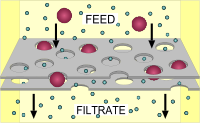
Photo from wikipedia
Aluminum manufacturing has been reported as one of the largest industries and wastewater produced from the aluminum industry may cause significant environmental problems due to variable pH, high heavy metal… Click to show full abstract
Aluminum manufacturing has been reported as one of the largest industries and wastewater produced from the aluminum industry may cause significant environmental problems due to variable pH, high heavy metal concentration, conductivity, and organic load. The management of this wastewater with a high pollution load is of great importance for practitioners in the aluminum sector. There are hardly any studies available on membrane treatment of wastewater originated from anodic oxidation. The aim of this study is to evaluate the best treatment and reuse alternative for aluminum industry wastewater using membrane filtration. Additionally, the performance of chemical precipitation, which is the existing treatment used in the aluminum facility, was also compared with membrane filtration. Wastewater originated from anodic oxidation coating process of an aluminum profile manufacturing facility in Kayseri (Turkey) was used in the experiments. The characterization of raw wastewater was in very low pH (e.g., 3) with high aluminum concentration and conductivity values. Membrane experiments were carried out with ultrafiltration (PTUF), nanofiltration (NF270), and reverse osmosis (SW30) membranes with MWCO 5000, 200–400, and 100 Da, respectively. For the chemical precipitation experiments, FeCl3 and FeSO4 chemicals presented lower removal performances for aluminum and chromium, which were below 35% at ambient wastewater pH ~ 3. The membrane filtration experimental results show that, both NF and RO membranes tested could effectively remove aluminum, total chromium and nickel (>90%) from the aluminum production wastewater. The RO (SW30) membrane showed a slightly higher performance at 20 bar operating pressure in terms of conductivity removal values (90%) than the NF 270 membrane (87%). Although similar removal performances were observed for heavy metals and conductivity by NF270 and SW30, significantly higher fluxes were obtained in NF270 membrane filtration at any pressure that there were more than three times the flux values in SW30 membrane filtration. Due to the lower heavy metal (<65%) and conductivity (<30%) removal performances of UF membrane, it could be evaluated as pretreatment followed by NF filtration to protect and extend NF membrane life. The water treated by both NF and RO could be recycled back into the process to be reused with economic and environmental benefits.
Journal Title: Environmental Science and Pollution Research
Year Published: 2018
Link to full text (if available)
Share on Social Media: Sign Up to like & get
recommendations!